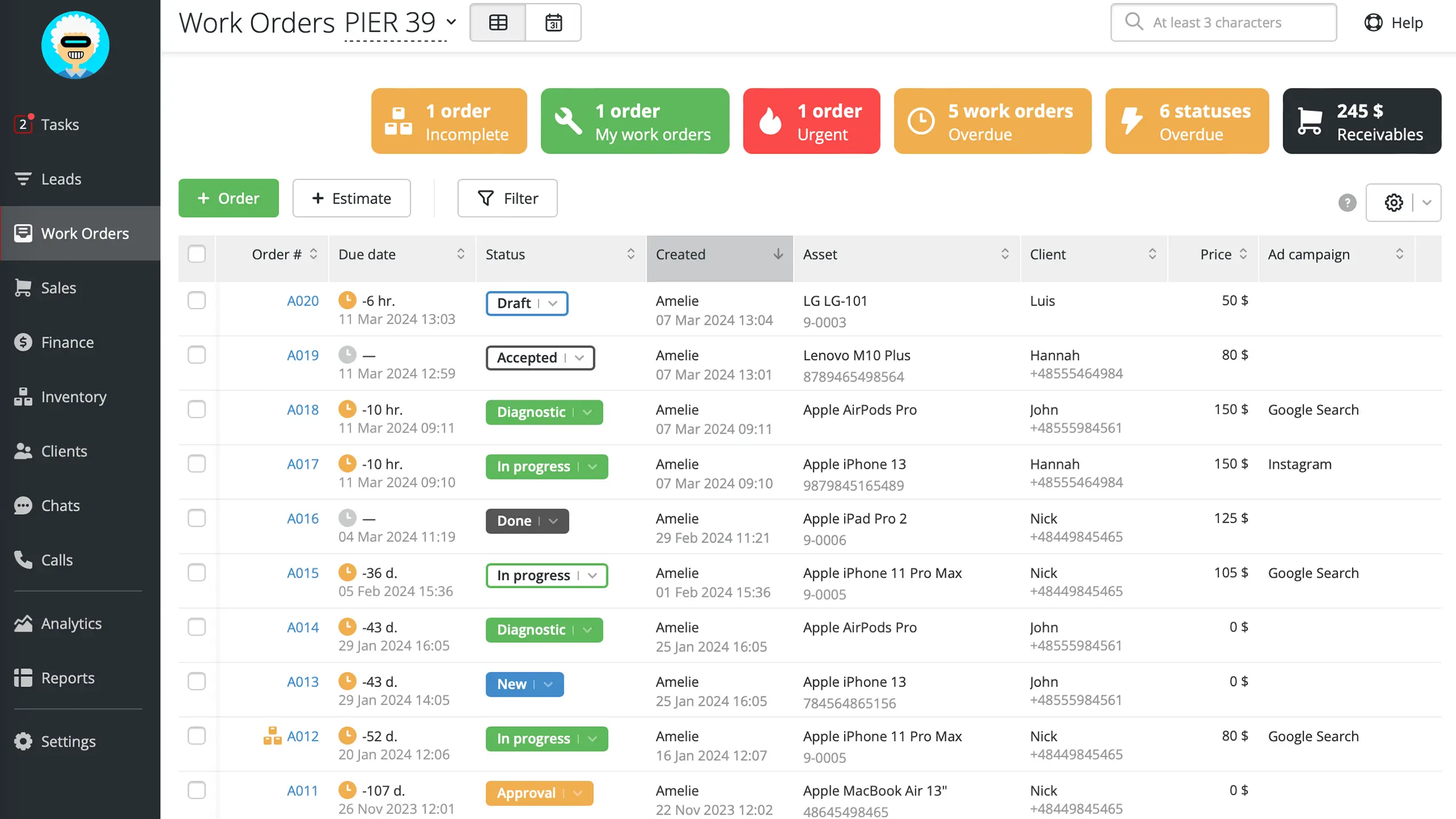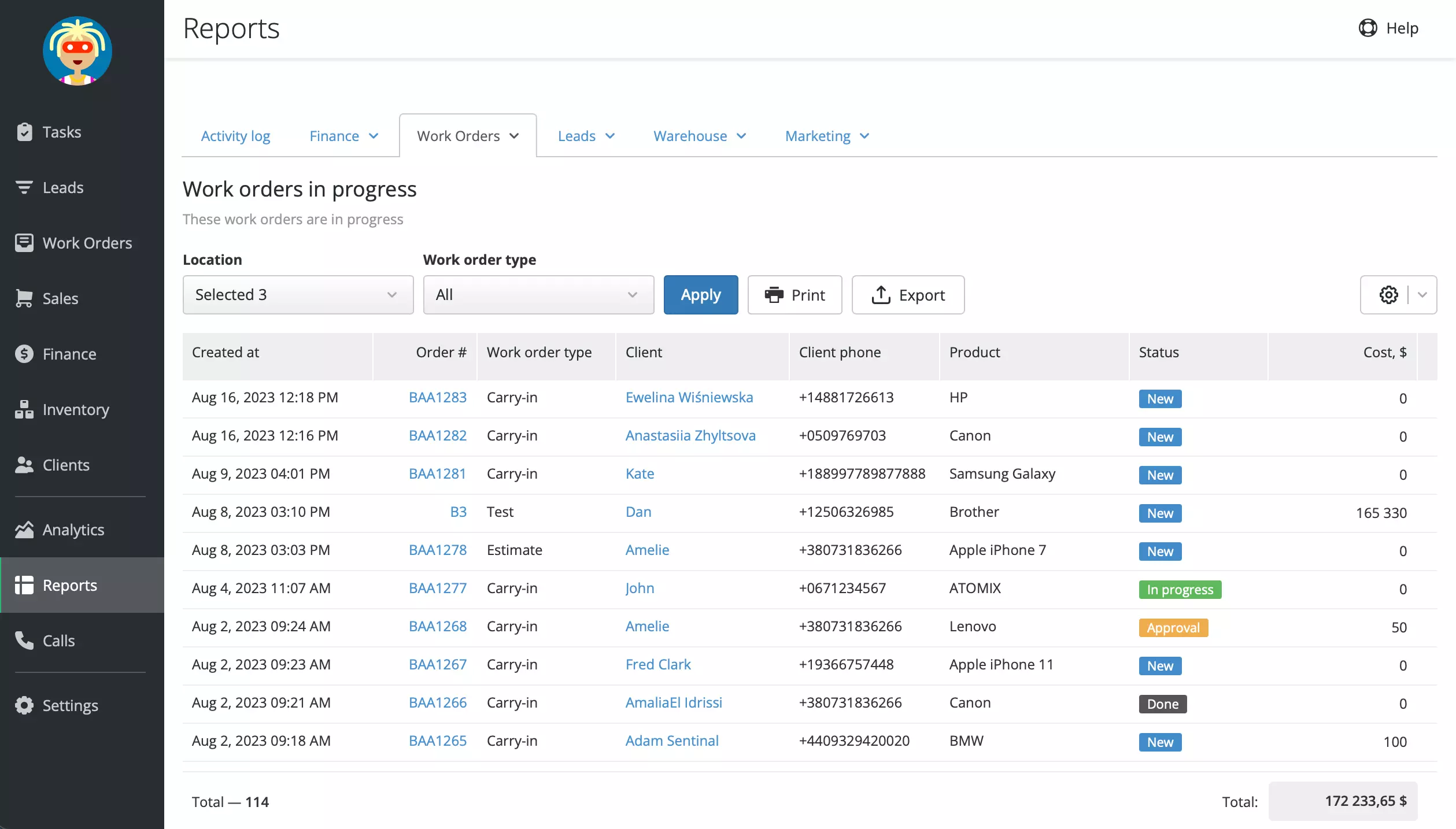Work Order Management Best Practices
Find out how to best manage work orders in repair shops and field service companies.
Table of Contents
What is a Work Order?
How to Organize Work Orders
Work Order Reporting
Frequently Asked Questions about Organizing Work Orders
Final Thoughts
A well-managed work order system can make all the difference in the success of your small service business. Discover how to use work orders to efficiently manage your jobs, predict your workload, proactively allocate resources, and keep your customers satisfied.
What is a Work Order?
A work order is a formal request for a customer to provide services. You can use various work order types—how many and with what priority depends on your services, how you do business, and the number of daily operations your employees do. Here are some examples of their grouping:
Routine and Urgent. Routine work orders are typically submitted 30-60 days in advance for repair services, energy efficiency upgrades, or service scheduling. An urgent one is a service work order or repair work order that is needed immediately, typically within 24 to 48 hours' notice.
Paid and Warranty. You may use such work order types if you want to use an automatic system of payroll calculation for employees: a percentage-based reward for regular repairs and a custom rate for warranty works.
By Devices or Locations. Use this grouping if you have one location specializing in HVAC repair and another in appliances. You can divide jobs into in-store and field work orders if you offer both services.
These are just some of the ideas; as you can see, unlimited customization possibilities exist.
How to Organize Work Orders
One crucial tactic for keeping your business running smoothly is to have a reliable system for handling work orders. There are numerous ways to deal with them; it depends on the extent of the system you are trying to establish.
One way would be to have a system where workers are responsible for executing work orders independently, meaning the person bringing the work order to the business would have to know what resources are necessary for execution.
Another way would be to have a list of resources for each work order that can be executed by whichever worker or staff member is available.
Whatever way you decide to go, there are two things you should do to build an effective work order process: map out your workflow and find the best work order software that suits all the needs of your business.
Understanding Your Workflow
Think about the work that needs to be accomplished each day. Consider all the tasks that need to be completed, which are urgent, and which can wait a bit. Describe the flow of events for each task. Put them in a logical order of how they must be done, and write a name for each workflow stage. And voila! You can use these status names when setting up status sequences in your work order tracking system.
What is Work Order Management in the Cloud?
Without innovative technology, your efforts to organize effective workflows would result in potential problems like missing deadlines, incomplete work, and disappointed customers.
Keeping track of all your work in a specialized program is one of the best practices for creating a streamlined work order management process. It not only helps you stay organized, but it also empowers you to achieve more in less time. For example, when using Orderry, you’ll be more efficient and productive by reducing the time it takes to find, prioritize, follow up on, and complete a work order. It also provides a way to track employee performance, leading to a more productive and efficient workforce.
Implementing such a system is affordable for small businesses as this solution operates in the cloud and uses a subscription-based model, so you don’t need to invest a fortune to get started. A SAAS system can allow an entire team to quickly enter, track, and update work orders. It can also ensure that all information is entered by the right person at the right time. All work orders are displayed in a table view where you can sort them by work order types, assignees, status, or urgency.

Screenshot of Work Orders in Orderry
Work Order Reporting
Keeping track of your work orders will allow you to see how many jobs you need to place each day to stay profitable, how many are on hand or due, the type of jobs you are receiving, which of them get closed successfully, and much more. With work order control and deep analytics, you will get a better idea as to the amount of time it takes your team to fulfill work orders, how often they become overdue, and if you need to hire more help.
Screenshot of the Work Order Report in Orderry
Frequently Asked Questions about Organizing Work Orders
What software solution do small businesses use to manage work orders?
Small businesses often use all-in-one solutions to streamline operations, automate manual tasks, and improve efficiency. This software allows companies to create and track jobs like repair work orders and maintenance requests, assign tasks to employees, organize inventory, and monitor real-time progress. It can also integrate with other business tools, such as communication gateways and payment services, to create a cohesive and efficient work environment.
What is work order management and how to improve it?
This term refers to efficiently and effectively tracking and managing the work orders within an organization. This includes creating new work orders, assigning them to employees or contractors, monitoring the progress of the work, and ensuring that it is completed on time and within budget.
If you're running a service business, you know how important it is to keep track of your work orders. Whether managing a team of technicians or working solo, a streamlined work order process is essential for delivering high-quality service to your clients. Here are some steps you can take to improve your work order management process:
- Use a digital work order system. By digitizing your work orders, you can easily track and manage all aspects of your service business, including scheduling, invoicing, and customer services.
- Standardize your work cycles. This means creating a consistent set of procedures for creating, assigning, and completing work orders. By establishing clear guidelines, you can ensure that everyone on your team knows what's expected of them and that work orders are handled consistently and accurately.
- Continuously evaluate and improve your process. This means tracking key metrics such as response time, completion rate, and customer satisfaction and using that data to identify areas for improvement. By staying focused on continuous improvement, you can ensure that your service business always operates at peak efficiency and delivers the best possible service to your customers.
What is a service work order?
A service work order outlines the details of a service that needs to be performed. It typically includes the customer's name, contact information, the type of service requested, the date and time the service is required, and any specific instructions or requirements. Service work orders are essential for ensuring that the service provider understands the customer's needs and can deliver the requested service effectively. They also serve as a record of the work performed, which can be helpful for billing and tracking purposes.
What is a repair work order?
A repair work order is a document used to request maintenance or repair services for equipment, vehicles, or property. It typically includes details such as the problem's nature, the issue's location, the repair's urgency, and any specific instructions for the repair technician. This document helps to ensure that repair requests are appropriately documented and prioritized, leading to more efficient maintenance processes and timely resolution of issues.
Final Thoughts
Work orders are an organizational tool that can help report job status and material usage and improve your company's workflow. Organizing your work orders is one of the most important things you can do as a manager to boost efficiency and productivity. There are many benefits to using a specialized software program; for example, you’ll save time and money and be able to track and identify patterns that lead to overdue work orders or costlier repairs.


